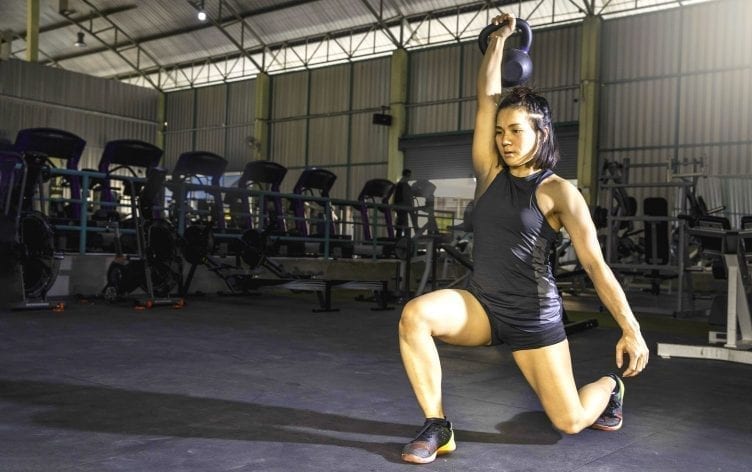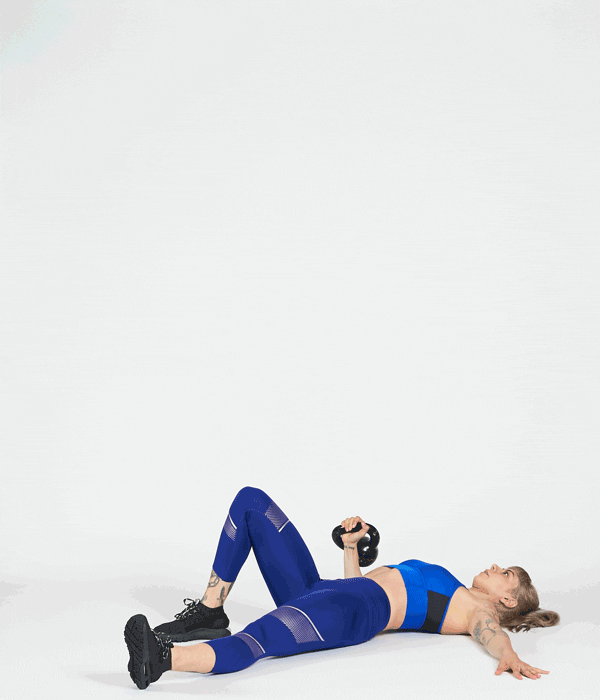
The Turkish get-up (TGU) is the total package when it comes to exercise. This full-body move takes you from lying flat on your back to standing upright, then back to lying flat.
It may sound simple, but there’s a twist: You’re holding a weight overhead with one arm the entire time. This component makes the TGU a technical and challenging movement, but it’s a movement that’s well worth learning.
Read on to learn what makes the TGU an exercise worth adding to your fitness routine. Then, assuming you’re ready to give it a go, use our tips to master it.
THE BENEFITS OF THE TURKISH GET-UP
The TGU is a fluid movement that involves several steps. Every rep targets several muscle groups, builds full-body strength and stability, and gets you working in every plane of motion. It also requires your brain to participate so you can coordinate your limbs every step of the way. And, like most exercises that hit several large muscle groups, the TGU can get your heart rate up in a flash.
“The get-up is very special because even the individual pieces of the move are solid exercises in and of themselves,” says Adrienne Harvey, a kettlebell and calisthenics instructor. String them all together, and you’ll get a move that hits practically every muscle in your body.
The TGU is especially challenging for the shoulders, triceps, upper back, abdominals, obliques, glutes and quads. You don’t even need the kettlebell to feel the exercise, Harvey notes.
WHAT THE PERFECT BODYWEIGHT TURKISH GET-UP LOOKS LIKE

THE SETUP:
Lie on your back and bend your right knee, so your right foot is flat on the floor. Make a fist with your right hand and extend it toward the ceiling, making sure your right shoulder is firmly pressed into the ground, supporting your right arm. Let your left arm and leg spread out on the floor so they’re extended away from your midline at a 30–45-degree angle.
PART ONE:
Leading with your chest, push through your right foot (especially the heel) and roll toward the left side until you’re propped up on your left elbow. “The movement is more of a ‘roll-up’ than a ‘sit-up,’” says Harvey. Continue rolling upward until your left arm is straight, still holding your fist straight overhead. Keep your gaze on your fist the entire time and don’t let your left leg or foot leave the ground.
PART TWO:
While still looking at your fist, press through your left hand and right foot to lift your hips off the floor. Lift just enough to sweep the left leg under the body and place your left knee on the ground where you were just seated. “The body then shifts slightly so that the raised arm is directly over the hand on the ground,” says Harvey. Then, pivot your left knee to windshield-wiper your lower left leg directly behind you. Tuck your left toes under so you end in a kneeling lunge position with your fist still overhead.
PART THREE:
Look ahead, and then push off your toes to stand up from the lunge.
PART FOUR:
Reverse the sequence by first stepping back from the standing position into a wide lunge, “making sure to give ourselves the proper amount of room to correctly come to the ground with control,” says Harvey. Keep reversing the movement step by step until you return to the starting position.
Once you’ve mastered the bodyweight version, do the TGU while balancing a shoe or yoga block on top of your knuckles. “No cheating with the thumb!” says Harvey.
Finally, practice the TGU with a light kettlebell or dumbbell. If you can, have an experienced trainer watch you the first time in case you lose control of the kettlebell while it’s overhead. Hopefully, however, you’ve selected a weight you can manage. Trying to chase a heavy weight before you’re ready is incredibly dangerous and “totally not worth it,” says Harvey.
WORK YOUR WAY TO A FULL TURKISH GET-UP
The TGU is a complex exercise with tons of moving parts. One of the best ways to learn it is to break it down.
“Learning the get-up in pieces (and then putting the pieces together in later workouts) is one of my favorite ways to teach the get-up to people who might otherwise get frustrated or overwhelmed by it,” says Harvey.
So, if you’re mystified by the TGU, start by practicing these components.
PUSH AND ROLL
Lie on your back and bend your right knee, so your right foot is flat on the floor. Make a fist with your right hand and extend it toward the ceiling, making sure your right shoulder is firmly pressed into the ground, supporting your right arm. Let your left arm and leg spread out on the floor, so they’re extended away from your midline at a 30–45-degree angle.
Leading with your chest, push through your right foot (especially the heel) and roll toward the left side until you’re propped up on your left elbow. Continue rolling upward until your left arm is straight, still holding your fist straight overhead. Keep your gaze on your fist the entire time, and don’t let your left leg or foot leave the ground. Then, slowly lower back down to the floor. Repeat. To make it more challenging, add a kettlebell.
HALF-KNEELING KETTLEBELL WINDMILL
Begin in a half-kneeling position with a kettlebell in the racked position, and your thumb near or against your chest. The kettlebell should be on the same side as your front leg. From here, press the kettlebell overhead. Look up at the kettlebell. Shift your weight into your front hip and rotate your torso toward your front leg. As you rotate, slowly reach your free hand toward the ground. Keep your gaze on the kettlebell overhead and reach until the palm of your hand touches the ground. Reverse the movement with control to straighten your torso. Repeat, keeping the weight overhead.
SINGLE-ARM KETTLEBELL OVERHEAD REVERSE LUNGE
Stand with your feet hip-width apart. Hold a kettlebell in the racked position, thumb near or against your chest. Press the kettlebell toward the ceiling. With the weight overhead and your gaze fixed on an unmoving point, step your opposite foot back into a reverse lunge. The kettlebell should be on the same side as your front knee. Return to standing by pulling your body up through your front heel. Repeat, keeping the weight overhead.
THE BOTTOM LINE
The Turkish Get-up is a phenomenal total-body exercise with myriad benefits, including improving strength, balance and coordination. It’s important to learn the movement patterns of the exercise before diving in too quickly, however, so take it slow and lean on the expertise of a certified personal trainer, if accessible.
Make progress every day while you work on mini fitness and nutrition goals, like walking more steps or learning to track macros. Go to “Plans” in the MyFitnessPal app for daily coaching and easy-to-follow tasks to keep you motivated.
Tagsstrength trainingfitness